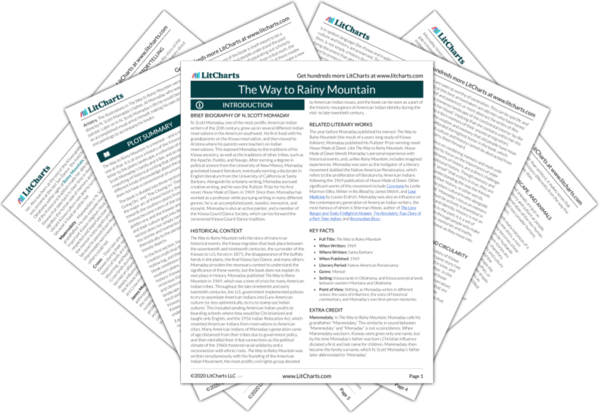Language and Storytelling
While The Way to Rainy Mountain is the story of the Kiowa migration, it is also, at its heart, a story about stories. Throughout the book, Momaday emphasizes the importance of storytelling as a tool of Kiowa survival, and he meditates on the power of language to not only represent the world around him, but also to act in the world—for Momaday words can inspire emotions, they can create magic, and they are always powerful…
read analysis of Language and StorytellingMemory and History
The Way to Rainy Mountain is a history of the Kiowa people, but it’s a nontraditional history; it takes the kind of written “factual” history to which Euro-American culture is accustomed and blends it with tribal lore and personal recollection. This is a surprising and radical choice in the context of most works of written history that value objectivity and evidence while discounting the ideas found in storytelling and myth. However, Momaday writes that, “The…
read analysis of Memory and HistoryOrigins, Linearity, and Circularity
The way that Momaday tells the story of Kiowa migration is nonlinear: he tells the same story two ways, moves forward and backward in time, and allows endings and origins to bleed into one another. In this way, Rainy Mountain is a challenge to the traditional linear narratives that structure most Western histories—narratives defined by having a clear beginning, middle, and end that are connected by cause and effect and anchored by a single perspective…
read analysis of Origins, Linearity, and Circularity
Nature, Landscape, and Animals
Nature, landscape, and animals are just as important to Kiowa history and culture as people. This shows the Kiowa veneration of the non-human world and suggests that the Kiowas did not consider humans, animals, and nature to be entirely distinct.
The stories that Momaday narrates include many instances of a blurred line between human and animal. In one story, a man turns into a water beast, and in another a boy becomes a bear. Spiders…
read analysis of Nature, Landscape, and AnimalsMixing of Cultures
Throughout the book, Momaday emphasizes the extent to which Kiowa culture has been shaped by blending—voluntarily and involuntarily—with other cultures. This cultural blending is mostly celebrated, since many of the pillars of Kiowa culture were learned and inherited from other tribes. From the Crows, for instance, the Kiowas learned their religion and began to do the Sun Dance, a central aspect of Kiowa culture. The migratory Kiowa lifestyle, also a defining part of Kiowa identity…
read analysis of Mixing of Cultures











